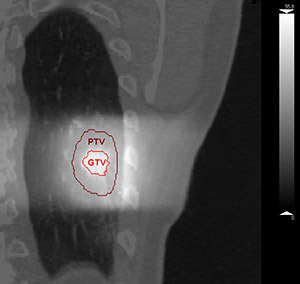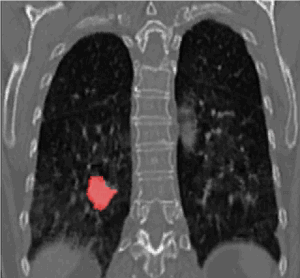Simulation and Evaluation of the Impact of Breathing Motion on Thoracic Dose Distributions for Different Radiation Delivery Techniques using 4D CT Data
Modern radiation therapy techniques are capable to deliver dose within millimeter or even submillimeter precision. Highly accurate knowledge about position and shape of anatomical and pathological structures is a prerequisite to exploit the potential of these techniques. However, in current clinical practice treatment planning is still based on 3D CT imaging; movements of anatomical and pathological structures are not represented. Therefore uncertainties arising are accounted for by introducing safety margins (fig. 1). Margins are usually defined with respect to observations based on appropriate patient populations. This causes problems for the individual patient: On the one hand safety margins could be too large; this would increase the volume of healthy tissue to be irradiated which in turn would increase the likelihood of treatment related complications. On the other hand margins could be too small; this would limit the chances of successful treatment. Furthermore, for certain radiation delivery techniques such as intensity modulated radiotherapy the interplay of segmentation (i.e. application of small radiation fields of only a few monitor units) and target motion raises the risk of cold and hot spots (areas of high or low dose when compared to the planned dose).
The problems gain in importance with increasing motion amplitudes. Consequently, breathing motion - which causes motion amplitudes of up to several centimetres (fig. 2) - states a profound problem within the field of radiation therapy of thoracic tumors. By means of 4D CT data sets of lung tumor patients our project aims to answer fundamental questions within the field of radiation therapy of thoracic tumors. As a starting point we analyze breathing dynamics; related questions are here: What kind of motion patterns of anatomical and pathological structures exist? Do current safety margin concepts used in clinical practice cover the motion patterns? Is there a chance to improve the safety margin concepts by our observations?
In the next step we study the impact of breathing motion on the dose distribution applied to the patient; these analyses are done within a computer based simulation study. Different radiation delivery techniques are simulated such as 3D conformal radiation therapy and intensity modulated radiotherapy. For the different techniques the advantage of gated radiation delivery over ungated radiation delivery is examined.
This project is funded by the Deutsche Krebshilfe (DKH-Nr. 107899).


Selected Publications
- René Werner, Jan Ehrhardt, Alexander Schmidt-Richberg, Bernd Bodmann, Florian Cremers, Heinz Handels
Dose Accumulation based on Optimized Motion Field Estimation using Non-Linear Registration in Thoracic 4D CT Image Data
In: Dössel O., Schlegel W.C. World Congress on Medical Physics and Biomedical Engineering, WC 2009, Springer Verlag, Berlin, IFBME Proceedings 25/IV, 950-953, 2009. - R. Werner, F. Fehlauer, J. Ehrhardt, D. Albers, F. Cremers, R. Schmidt, H. Handels: Impact of Breathing Phase on Thoracic Dose Distribution - an IMRT Treatment Planning Study using 4D CT Image Data. 9th Biennial ESTRO Meeting on Physics and Radiation Technology For Clinical Radiotherapy of the European Society of Therapeutic Radiology, Barcelona, Radiotherapy & Oncology 84(Supplement 1): 153, 2007.
Project Team
Dipl.-Inf. Dipl.-Phys. René Werner
Dr. Jan Ehrhardt
Prof. Dr. Heinz Handels
Cooperation Partners
Dr. rer. nat. Florian Cremers
Klinik und Poliklinik für Strahlentherapie und Radioonkologie
Universitätsklinikum Hamburg-Eppendorf

- Research
- AI und Deep Learning in Medicine
- Medical Image Processing and VR-Simulation
- Integration and Utilisation of Medical Data
- Sensor Data Analysis for Assistive Health Technologies
- Medical Image Computing and Artificial Intelligence
- Medical Data Science Lab
- Medical Deep Learning Lab
- Junior Research Group Diagnostics and Research of Movement Disorders
- Former Medical Data Engineering Lab
